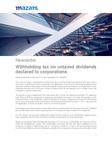
Withholding tax on untaxed dividends declared to corporations
This new tax reform, covered by the Financing Law, could have had more technical and clear criteria at the time of drafting its text to avoid that in the application of some of its measures taxpayers were faced with different interpretations that will certainly require future clarifications and hopefully through regulatory decrees and not through unified concepts (which for the taxpayer are no longer of any use to support a specific treatment).
The above is clearly evidenced in the new article 242-1 of the Tax Statute (hereinafter ET) added by Law 1943 of 2018 by introducing a supposed anticipated mechanism of income tax payable by the final beneficiary of the dividends (resident individual or foreign investments) through the withholding at the source practiced to the first company receiving the dividend at the rate of 7.5% if, according to the application of article 49 ibidem, it turns out not to be taxed.
The background of the provision is none other than to avoid the deferral of the payment of the dividend tax by individuals when, before reaching them, it must pass through a network of companies.
For this reason, the provision additionally states that the credit of such withholding, despite having been charged to the first-born company, must be transferred to the final beneficiary.
Making a comparison with international regulations on income tax on dividends, we find that, in Chile, under the attributed tax system, the shareholders are taxed with the final taxes (additional tax for foreigners or global complementary tax for individual’s resident in Chile) in the same taxable period in which their effective income is declared or profits of the respective company are distributed. In this system, the company/shareholder binomial is taxed at a rate of 35% (25% company and 10% foreign shareholder, for example).
The way in which this composite taxation has been implemented is explained as follows: i) the corporation liquidates and pays the corporate tax at the rate of 25%; ii) at the time the dividend distribution is made, and for purposes of applying the 35% withholding tax payable by the shareholder, the tax paid in the corporation (the equivalent of 25%) is added to the distributable profit and on that basis the deduction is applied; iii) on the result they are allowed to deduct, as a tax credit, the tax paid by the corporation (first category) and the shareholder's final tax is obtained which, added with the company, results in being 35%. An example will show us the above:
Returning to our domestic case and applying the same logic, we should have a much simpler practical solution than the reading of the norm would seem to indicate. In effect, the mentioned mechanism allows the Tax Administration to collect the tax associated to the dividend in advance but allows the credit to be transferred to the final beneficiary.
Strictly speaking, it is not possible to indicate that the application of this provision means that the dividends of the first company are taxed at the rates described in the company, but under the solution that we want to propose, by a sound logic, it is concluded that the taxpayer is the company receiving the first distribution since:
1. Practicing the withholding at the source to the first company, generates a practical impediment in the transfer of such withholding to a second company, and consecutively until reaching the final beneficiary.
2. For the same it will be necessary to identify the third party at the end of the chain, which will not always be feasible.
3. The decree of dividends among all the companies may cover several taxable periods, and therefore, if an account receivable is caused, it would affect the amount of assets subject to the calculation of the tax under the presumptive income system for those who pay taxes under this system.
Therefore, it will be necessary to consider as a practical measure, the recognition of an expense in that company subject to withholding, and consequently, when the dividend is distributed to the final beneficiary, the credit generated from the first withholding is subtracted from the withholding to be made, being only the surplus what remains taxed to the shareholder (15% - 7.5%). For this purpose, the withholding practiced must be controlled through certifications, in order to inform subsequent shareholders (companies).


